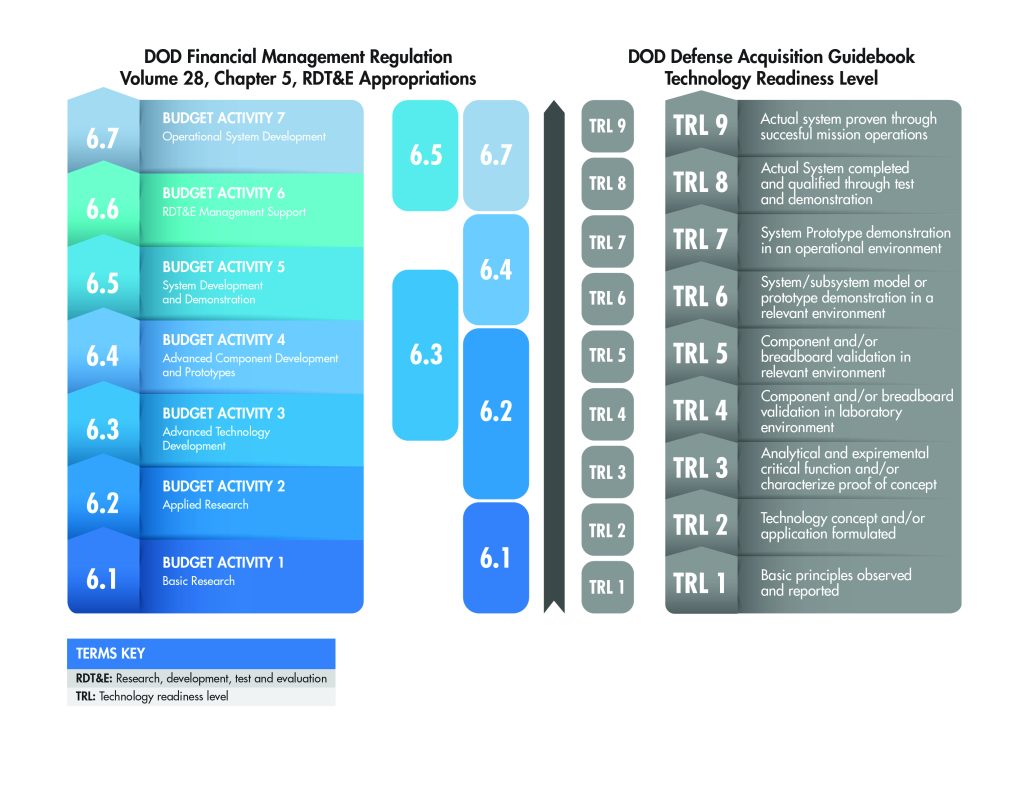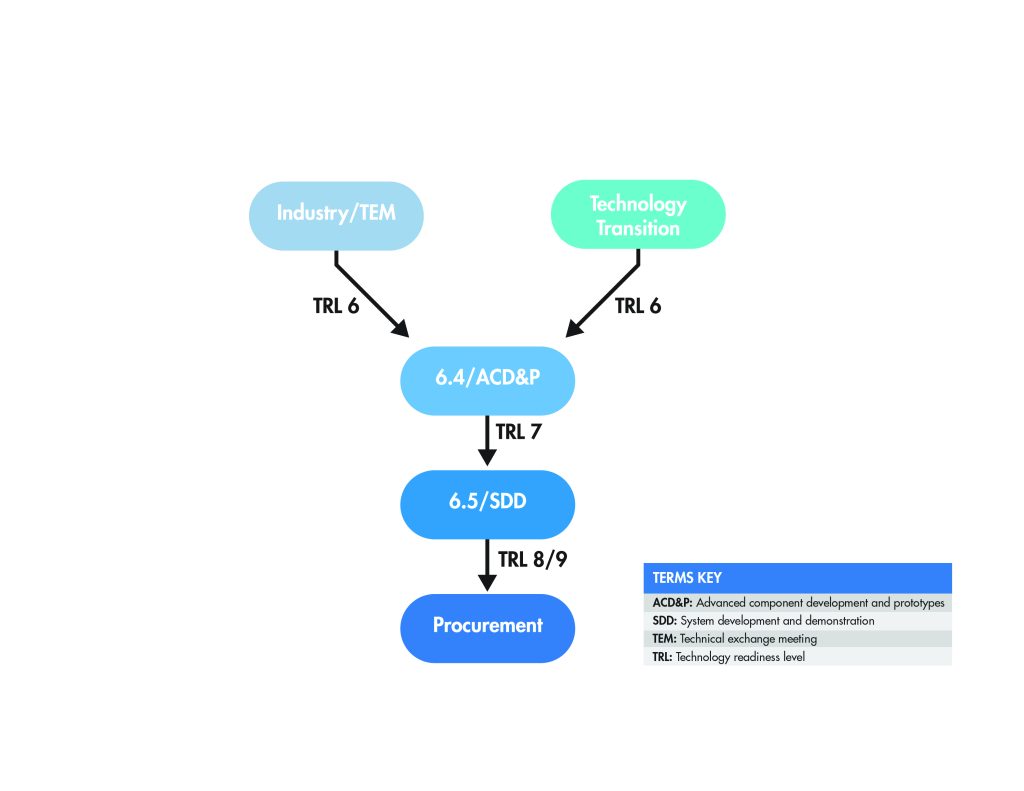
TESTING THE LIMITS: National Guard Soldiers don M50 gas masks in response to a simulated chemical attack during a Combat Support Training. Some Army prototypes that showed promise, followed by system improvements and Soldier touch point feedback have stalled, teetering over the technology transition valley of death. (U.S. Army Reserve photo by Sgt. Brandon Whittemore)
PEO C3T, Network Cross-Functional Team and C5ISR Center work to find a route around the technology transition valley of death.
by Tyler J. Cook
Many in the Army acquisition community are familiar with “the technology transition valley of death”—the all-too-common occurrence when emerging science and technology programs fail to successfully transition to a project management office for potential integration, acquisition, production and fielding.
The Army’s technology transition process plays a key role in delivering emerging capabilities to U.S. forces and retaining technological overmatch against peer and near-peer adversaries. Global tensions and the potential for conflict with tech-savvy threats have renewed the Army’s interest concerning the plight of technology development programs and their successful transitions to project management offices.
In 2019, several commercial prototype-development efforts focused on improving network resiliency and capacity were initiated as part of the Army’s two-year interval network modernization capability set acquisition and fielding process. These prototypes showed significant promise and highlighted the Army’s enhanced collaboration with industry and industry’s innovation to meet emerging capability requirements. The Army conducted successful assessments on these prototypes, followed by system improvements and touch point events with Soldier feedback to inform additional enhancements.
However, some of the prototypes stalled, teetering over the technology transition valley of death, because of evolving maturity levels or the lack of additional research, development, test and evaluation (RDT&E) funding needed to improve the prototype and integrate with existing Army network communications capabilities (Figure 1). Without the established funding, the technology transition bridge had only been built halfway, increasing the likelihood of prototypes toppling into the valley of death.

FIGURE 1-TEETERING OVER TECHNOLOGY:Teetering over the technology transition valley of death. (Graphic by Lynn Bellia, PEO C3T)
The Army implements technology transitions when a science and technology (S&T) system has reached a certain maturity level, known as a technology readiness level (TRL), which is measured through a technology readiness assessment (Figure 2). Without the proper processes and funding in place, at best, any S&T transition will be in knowledge and lessons learned only, and not the systems themselves. Although the transition of knowledge is always beneficial, the absence of transitioned systems keeps capability gaps open and leaves the Army more susceptible to U.S. adversaries.
UP TO THE CHALLENGE
The Army is addressing technology transition challenges through the establishment of new integration offices at the Program Executive Office for Command, Control and Communications ‒ Tactical (PEO C3T), which work in tandem with the Army Futures Command’s cross-functional teams and the Combat Capabilities Development Command Computers, Communications, Cyber, Intelligence, Surveillance and Reconnaissance (C5ISR) Center. Over the last few years, these organizations, through tightly aligned goals and collaboration, have significantly increased S&T reviews, enhanced transition agreement processes and strategic reviews of acquisition plans, along with many other efforts.
While early project management office buy-in and transition agreements are critical for prototype technologies and capabilities, without these offices receiving additional RDT&E appropriations, the technology transition valley of death remains the unavoidable destination for many emerging modernization efforts. Project Manager (PM) Tactical Network is working closely within its parent organization, PEO C3T, together with the Network Cross-Functional Team and the C5ISR Center to lay the strong foundations required to truly bridge the technology transition valley of death and enter product development.
RDT&E BUDGET ACTIVITIES-4: ADVANCED COMPONENT DEVELOPMENT AND PROTOTYPES
The Army’s establishment of dedicated Advanced Component Development and Prototypes (6.4) RDT&E funding for use across PEO C3T is perhaps the single most important building block in the successful transition of mature S&T programs to their respective project management offices. This funding line enables the development, system integration and demonstration of technologies and prototypes at TRL 6 and 7 (Figure 2).

FIGURE 2
READINESS LEVEL: Financial Management Regulation – Technology Readiness Level (FMR-TRL) Map1. (Graphic by DAU, adjusted by the author).
To date, PM Tactical Network leverages two pathways to take advantage of this RDT&E funding (Figure 3), although there are others under consideration. The first is through formal technology transitions from the C5ISR Center to the project management office, and the second is through technical exchange meetings (TEMs) with industry.

FIGURE 3- GOING WITH THE FLOW: Conceptual flow of technology transition pathways and development. (Graphic by the author)
Formal S&T Pathway: The Army’s formal S&T pathway is the more traditional avenue for technology development. It generally includes multiple years of basic research (6.1 funding), applied research (6.2 funding), and advanced technology development (6.3 funding). Midway between the start and transition of an S&T program, the gaining project management office and the C5ISR Center sign a transition agreement, which identifies funding, knowledge points, decision points, technical readiness assessment criteria, transition product, etc. Once the technology is validated as TRL 6, and meets other project-specific transition criteria, it transitions to the project management office for ownership and additional technology maturation.
TEM Pathway: An alternate avenue to technology transition is to leverage the semi-annual network modernization technical exchange meetings, which are co-hosted by PEO C3T, the Network Cross-Functional Team and the C5ISR Center. These formal exchange meetings provide industry with updates and insight concerning the Army’s network modernization strategy, including network modernization capability sets and development, through warfighter panels that highlight specific TEM network modernization efforts to fill capability gaps. Following a TEM, the Army solicits whitepapers, which industry submits to support potential prototyping efforts for specific TEM topics using 6.4 RDT&E funding.
Even though some TEM prototypes have not currently transitioned, the knowledge gained from these efforts helped enhance the technology transition and integration process for future S&T transitions that impact the Army’s unified network. The concept and lessons learned from these prototypes have been carried forward as design goals for capability set 23.
RDT&E BUDGET ACTIVITIES-5: SYSTEM DEVELOPMENT AND DEMONSTRATION
To ensure the transition of products and not just knowledge, Army stakeholders are creating a stronger, more complete bridge to successful technology transition. In 2022, the Army announced new dedicated System Development and Demonstration (6.5) funding, to be used beginning fiscal year 2024, to support the integration and testing of efforts that have matured past the 6.4 RDT&E funding stream and TRL 7. This “new start” funding line is dependent and modeled after the existing PEO C3T 6.4 RDT&E funding line. Efforts will vary each year as systems meet the required TRL entry and exit gates. What will not change is the positive impact 6.5 funding will have on future Army network modernization efforts, including programs such as: S&T’s Next Generation Tactical Terminal, a common satellite system that supports the Army’s family of terminals approach; Non-Traditional Waveforms, which is a high-throughput line-of-sight communications capability; and the TEM 5 Intra Command Post Node Wireless system.
Fiscal year 2024 will be a critical year of technology transitions for PM Tactical Network and PEO C3T as additional 6.4 RDT&E efforts from S&T transitions and the 6.5 RDT&E funding line begin. These organizations are proactively applying lessons learned to assist with technology transition prioritization, to inform senior leader decisions, and to prepare maturing emerging technologies.
TECHNOLOGY TRANSITION FOCUS AREAS, RECOMMENDATIONS
In today’s fiscally constrained environment, prioritization of efforts remains critical throughout the technology transition and development decision process. PEOs and project management offices can leverage the following focus areas to help ensure successful technology transition and avoid the valley of death:
- Establish a 6.5 RDT&E funding line. A dedicated 6.5 RDT&E funding line provides the project management office with the flexibility to choose which efforts to fund across its portfolio based on maturity, schedule, requirements and impact to the warfighter. As new capability gaps and potential solutions are identified, funding can be adjusted much faster with 6.5 funding than it can by creating a program specific funding line.
- Assess the type of transition. What is being transitioned? Is it only knowledge, or is the transition a physical or virtual product that fills a critical capability gap? This consideration can be a useful in determining an S&T effort’s return on investment beyond 6.4 RDT&E funding.
- Plan the transition path. Is the technology being transitioned via the TEM or the S&T pathway? Which path reduces risk the most or could be more impactful in the prioritization of future efforts? Are there other transition pathways that could be taken or created? As additional transitions occur across the PEO, is there a more proven path that could provide capabilities to close critical gaps?
- Limit salami slicing. Rather than partially funding multiple projects, fully fund one effort before funding the next. This does introduce risk in the unfunded project becoming technically obsolete if it is deferred to a later year, and there is risk in going “all in” on the funded project and it failing to fully transition into production. However, “failing early” can be useful to the Army, as seen in Special Operations acquisition, which uses a “fail faster” approach to make informed decisions much earlier in a project’s life cycle. Showing that a project management office can successfully transition an effort by demonstrating the integrated system within an operational environment, may improve the likelihood of funding in the future versus the salami slice approach where efforts may never fully mature.
- Mature the Manufacturing Readiness Level (MRL). Much of the PM Tactical Network portfolio includes the integration of commercial-off-the-shelf products that are already in production and have a high MRL. With planned technology transitions, renewed and increased focus should be placed on assessing and maturing MRL concurrently with TRL to ensure the production process is established and prepared to meet Army production requirements.
- Determine the Transition Confidence Level (TCL). Recent program reviews by PEO C3T, Network Cross-Functional Team and C5ISR Center have identified the need for metrics concerning the success and confidence levels across the technology transition community. The TCL, as discussed by Anthony Davis and Tom Ballenger in their January-February 2017 article in Defense AT&L, is another metric that should be adopted by project managers to assist with prioritizing efforts across the portfolio (Figure 4).

FIGURE 4- CONFIDENCE CHARACTERISTICS: The characteristics of Technology Confidence Levels (TCLs). (Image by the author)
CONCLUSION
Army network modernization stakeholders will continue to streamline and optimize the technology transition process using these and other technology transition focus areas and processes. Forward thinking, analysis, planning and leveraging lessons learned will prepare project management offices for adapting near-term 6.4 RDT&E efforts and follow-on 6.5 RDT&E systems. PM Tactical Network and PEO C3T are working closely with Army network modernization stakeholders to plan and implement the successful transition of development efforts from the S&T community and industry to fielded Army programs. These efforts will help ensure the latest technologies reach U.S. forces as rapidly and effectively as possible, enabling decision dominance and mission success in multidomain operations against increasingly sophisticated enemies.
For more information, go to the PEO C3T website at http://peoc3t.army.mil/c3t or contact the PEO C3T Public Affairs Office at 443-395-6489 or usarmy.APG.peo-c3t.mbx.pao-peoc3t@mail.mil.
TYLER J. COOK is the assistant product manager for science and technology integration, assigned to PEO C3T’s Project Manager for Tactical Network, Product Lead for Unified Network Capabilities, and Integration. He holds an M.E. in systems engineering from Stevens Institute of Technology and a B.S. in mechanical engineering from Penn State University. He is a DAWIA certified Practitioner in engineering.







